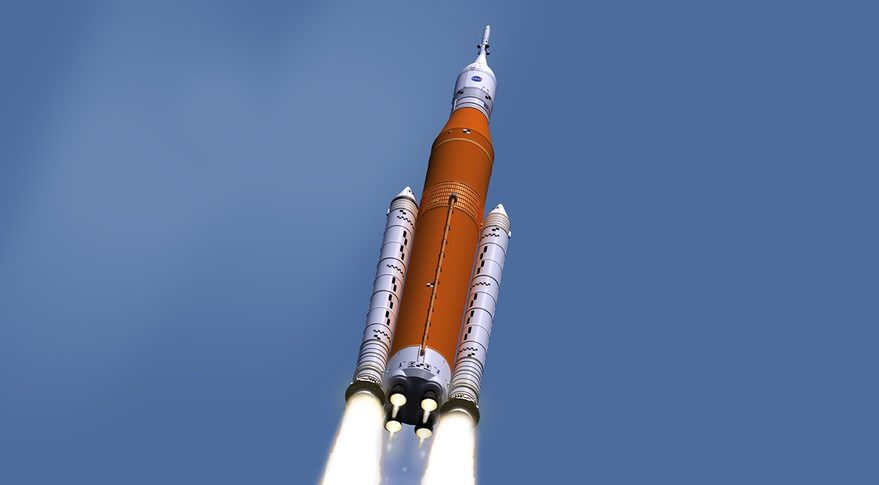
It'll cost several billion dollars more than originally planned to get NASA's huge Space Launch System (SLS) rocket off the ground, and that already-delayed first flight will probably end up being pushed back yet again, a new report by the agency's Office of Inspector General (OIG) finds.
NASA is counting on the two-stage SLS to launch astronauts toward deep-space destinations such as the moon and Mars. The giant rocket will also aid planetary exploration, helping robotic spacecraft reach distant targets in much less time than has hitherto been possible, agency officials have said.
Aerospace titan Boeing is responsible for the SLS' first, or core, stage. In 2012, NASA contracted with Boeing to build two SLS first stages, as well as one Exploration Upper Stage (EUS), an advanced second stage that will boost the rocket's payload-lofting capability. [Photos: NASA's Space Launch System for Deep Space Flights]
The space agency originally aimed to launch the first SLS flight — an uncrewed test called Exploration Mission 1 (EM-1), which will send NASA's also-in-development Orion crew capsule around the moon — in December 2017. The first crewed SLS-Orion flight, EM-2, was targeted for mid-2021.
Those schedules have slipped, however: NASA now aims to launch EM-1 in mid-2020 and EM-2 in the middle of 2022. And there will be cost overruns as well. The "Boeing Stages" contract runs through 2021, but NASA forecasts that the company will spend all of the allocated money by early next year, without the final delivery of a core stage or the EUS.
Which brings us to the new OIG report, which was released today (Oct. 10). It crystallizes the findings of a four-month-long audit (from April through August 2018) of Boeing's performance under the Stages contract, as well as NASA's "compliance with acquisition regulations, policies, and procedures supporting the SLS Program."
Those findings suggest that there will be additional bumps in the road for SLS development.
Get the Space.com Newsletter
Breaking space news, the latest updates on rocket launches, skywatching events and more!
"At its current rate, we project that Boeing will expend at least $8.9 billion through 2021 — double the amount initially planned — while delivery of the first Core Stage has slipped 2.5 years from June 2017 to December 2019 and may slip further," the OIG report states.
As a result of such issues, NASA will not be able to launch EM-1 in the currently targeted window, which runs from December 2019 through June 2020, the report's authors predict.
These cost increases and schedule slips "can be traced largely to management, technical and infrastructure issues driven by Boeing's poor performance," the OIG report adds. "For example, Boeing officials have consistently underestimated the scope of the work to be performed and thus the size and skills of the workforce required."
In addition, the hardware and software required for core-stage testing is two years behind schedule. Equipment-related problems and "an extreme weather event" — presumably 2017's Hurricane Harvey — have contributed to the delays and cost overruns, according to the report.
The OIG report makes seven recommendations to improve the "sustainability, accountability, and transparency" of core-stage and EUS development. NASA concurs with six of the seven recommendations, the report states; the only exception is Recommendation 6, which involves setting up a system whereby "technical monitors" rate the contractor's performance.
"To its credit, the SLS Program has taken positive steps to address management and procurement issues related to the Boeing Stages contract, including making key leadership changes; requesting reviews of Boeing's management, financial, and estimating systems; adding routine, in-depth performance reviews; and changing the procurement process to improve internal controls," the OIG report says. "However, the impact of these actions on improving Boeing's future contract performance is uncertain."
In a statement emailed to Space.com, NASA officials said that the SLS is the most complex launch system the agency has ever developed, and they acknowledged the challenges related to its design and manufacture.
But the officials also stressed the importance of the SLS to the agency's human-spaceflight plans. And they added that NASA fully supports Boeing, saying that the company has "already overcome many challenges" and continues "to show major improvements in efficiency and management."
"The recent report from NASA's Office of the Inspector General, along with other reviews, helps the agency improve performance," the NASA statement adds. "NASA and Boeing are well underway in implementing the report's recommendations, several of which are already yielding steady and significant improvements. NASA continues to carefully monitor SLS performance as the teams make significant progress on final assembly, outfitting and joining of the five major structural pieces of the SLS core stage at the agency's Michoud Assembly Facility in New Orleans for the first flight."
You can read the full OIG report here: https://oig.nasa.gov/docs/IG-19-001.pdf
Mike Wall's book about the search for alien life, "Out There,"will be published on Nov. 13 by Grand Central Publishing. Follow him on Twitter @michaeldwall. Follow us @Spacedotcom or Facebook. Originally published on Space.com.
Join our Space Forums to keep talking space on the latest missions, night sky and more! And if you have a news tip, correction or comment, let us know at: community@space.com.

Michael Wall is a Senior Space Writer with Space.com and joined the team in 2010. He primarily covers exoplanets, spaceflight and military space, but has been known to dabble in the space art beat. His book about the search for alien life, "Out There," was published on Nov. 13, 2018. Before becoming a science writer, Michael worked as a herpetologist and wildlife biologist. He has a Ph.D. in evolutionary biology from the University of Sydney, Australia, a bachelor's degree from the University of Arizona, and a graduate certificate in science writing from the University of California, Santa Cruz. To find out what his latest project is, you can follow Michael on Twitter.









